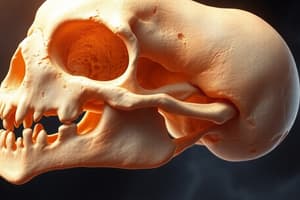Podcast
Questions and Answers
What is the primary function of osteoclasts?
What is the primary function of osteoclasts?
- Storage of minerals
- Bone demolition/breakdown (correct)
- Protection for the organs
- Bone formation
Compact bone surrounds spongy bone.
Compact bone surrounds spongy bone.
True (A)
What kind of bones are characterized by a tubelike structure and are longer than they are wide?
What kind of bones are characterized by a tubelike structure and are longer than they are wide?
Long bones
Which of the following is NOT a classification of bone?
Which of the following is NOT a classification of bone?
The central cavity of long bones that contains marrow is called the ______.
The central cavity of long bones that contains marrow is called the ______.
What is the term used for the cartilage covering the articular surface of a bone?
What is the term used for the cartilage covering the articular surface of a bone?
Which type of bones are described as having a cuboidal shape?
Which type of bones are described as having a cuboidal shape?
Irregular bones fit into a specific geometrical shape category.
Irregular bones fit into a specific geometrical shape category.
What are sesamoid bones primarily embedded in?
What are sesamoid bones primarily embedded in?
Match the following types of bones with their descriptions:
Match the following types of bones with their descriptions:
What classification of bone is characterized by not aligning properly when fractured?
What classification of bone is characterized by not aligning properly when fractured?
Flashcards are hidden until you start studying
Study Notes
Anatomy of Human Movement in Performance
Bone Composition and Types
- Bones are hard, strong tissues that can remodel and adapt through the activity of bone cells.
- Composed of minerals like calcium carbonate and calcium phosphate along with collagen.
Difference Between Spongy and Compact Bone
- Spongy Bone:
- Also known as cancellous or trabecular bone.
- Located within long bones, surrounded by compact bone.
- Characterized by a porous structure that reduces weight while maintaining strength.
- Compact Bone:
- Often termed cortical bone.
- Forms the outer layer, providing strength and resilience.
Bone Cells
- Osteoclasts: Responsible for bone resorption and breakdown.
- Osteoblasts: Responsible for bone formation and growth.
Functions of the Bone
- Protects vital organs (e.g., skull protects the brain).
- Acts as levers to facilitate movement.
- Stores fat and minerals, contributing to mineral homeostasis.
- Serves as a source for new blood cell production.
- Provides support and structural framework for soft tissues and ligaments.
Bone Classifications
- Regional Classification:
- Axial: Comprises skull, vertebral column, and thoracic cage; forms the body's central axis.
- Appendicular: Comprises the pectoral girdle, limbs, and bones of the hands and feet.
Long Bones
- Define as tubular structures that are longer than they are wide, primarily found in limbs.
Major Parts of Long Bones
- Diaphysis: Long tubular shaft part of the bone.
- Epiphysis: Ends of the long bone.
- Marrow Cavity: Central cavity containing bone marrow.
- Periosteum: Connective tissue sheath covering the compact bone.
- Hyaline Cartilage: Covers articular surfaces, aiding in smooth joint movement.
- Epiphyseal Plate: Located at both ends of growing long bones, critical for bone growth.
- Epiphyseal Line: Forms as a replacement for the growth plate around age 20.
- Metaphysis: Region of the diaphysis next to the epiphyseal line.
Types of Bones
- Short Bones:
- Cube-shaped with equal length and width, commonly found in hands and feet.
- Flat Bones:
- Thin, flattened structures typically curved, providing protection and support (e.g., skull, pelvis, scapula, sternum, ribs).
- Irregular Bones:
- Do not fit into other categories; lack a regular shape (e.g., vertebrae).
- Sesamoid Bones:
- Embedded within tendons, vary in size and shape among individuals.
Fracture Types
- Displaced Fracture:
- Broken bone segments are out of alignment.
- Non-Displaced Fracture:
- Bone remains in proper alignment, often classified as a closed fracture.
Studying That Suits You
Use AI to generate personalized quizzes and flashcards to suit your learning preferences.




